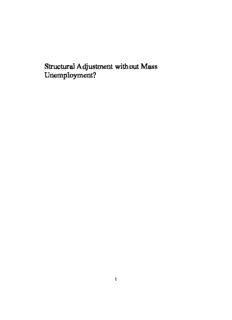
Structural Adjustment Without Mass Unemployment?: Lessons from Russia PDF
Preview Structural Adjustment Without Mass Unemployment?: Lessons from Russia
Structural Adjustment without Mass Unemployment? i Lessons from Russia Edited by Simon Clarke Professor of Sociology Centre for Comparative Labour Studies University of Warwick Coventry, UK Edward Elgar Cheltenham, UK (cid:149) Lyme, US (cid:1) Simon Clarke 1997. Copyright of individual chapters remains with the con- tributors. All rights reserved. No part of this publication may be reproduced, stored in a retrieval system, or transmitted in any form or by any means, electronic, mechani- cal, photocopying, recording, or otherwise without the prior permission of the publisher. Published by Edward Elgar Publishing Limited 8 Lansdown Place Cheltenham Glos GL50 2HU UK Edward Elgar Publishing Inc. P.O. Box 330 Lyme NH 03768 US British Library Cataloguing in Publication Data Contents List of Tables vii List of Figures xi Contributors xiii Introduction Simon Clarke 1 1 Structural Adjustment without Mass Unemployment? Lessons from Russia Simon Clarke 9 2 The Restructuring of Employment and the Formation of a Labour Market in Russia Simon Clarke, Veronika Kabalina, Irina Kozina, Inna Donova and Marina Karelina 87 3 Reviving Dead Souls: Russian Unemployment and Enterprise Restructuring Guy Standing 147 4 The Economic Development of Industrial Enterprises and the Dynamics and Structure of Employment Pavel Smirnov 186 5 How Vulnerable is Women(cid:146)s Employment in Russia? Galina Monousova 200 6 Russian Unemployment in the mid-1990s: Features and Problems Tatyana Chetvernina 216 7 Economic Restructuring and Employment Promotion in a Russian Crisis Region: The Case of Ivanovo Maarten Keune 256 8 Aspects of Official Unemployment in Moscow and St Petersburg: The Views of the Registered Unemployed Kathleen Young 276 9 Households(cid:146) Experience of Unemployment in Moscow, St Petersburg, and Voronezh Nick Manning 310 References 332 Index 345 v List of Tables 2.1 Total Employment in Russia 72 2.2 Changes in Employment and Unemployment by Age and Sex, 1992(cid:150)95. Labour Force Survey data 85 2.3 Changes in Employment and Unemployment by Age and Sex, 1992(cid:150)96. RLMS data 86 3.1 Population and Employment, 1990(cid:150)95 150 3.2 Mortality from Murder and Suicide, 1990(cid:150)95 155 3.3 Women’s Share of Occupational Categories, 1995(cid:150)96 155 3.4 Distribution of Convictions, 1990(cid:150)95 156 3.5 Characteristics of the Russian Labour Flexibility Survey, 1991(cid:150)96 158 3.6a Indicators of Surplus Labour in Russian Industry, 1996 173 3.6b Indicators of Surplus Labour in Russian Industry, 1995(cid:150)96 173 3.7a Entitlement to Enterprise Benefits and Services, mid-1996 182 3.7b Entitlement to Enterprise Benefits and Services, Change 1995(cid:150)96 183 3.8 Benefits Entitlements for Worker Categories, mid-1996 185 4.1 Changes of Category of Enterprises, 1994(cid:150)96 188 4.2 Proportion of Enterprises of Various Types by Industrial Branch 189 4.3 Structure of Employment at Enterprises of Various Types 191 4.4 Separations of Particular Categories of Employee 193 4.5 The Main Reasons for Separations from Enterprises 195 4.6 Proportion of Pensioners at Various Types of Enterprises 196 4.7 Hiring Rate of Employees of Various Categories 198 5.1 Employment and Unemployment by Gender, 1992(cid:150)96 202 5.2 Changes in Labour Market Participation, 1992(cid:150)95 (%) 205 5.3 Changes in Labour Market Participation, 1992(cid:150)95 (mill) 205 5.4 Average Duration of Job Search by Unemployed (months) 206 vii viii List of Tables 5.5 Total and Female Employment by Sectors, 1990(cid:150)94 207 5.6 Relative Wages in Predominantly Male and Female Sectors 208 5.7 Indicators of Wages and Employment, by Gender, 1995 213 5.8 Perception of Employment Opportunities by Gender 214 6.1 Number of Unemployed Registered with the Employment Service and on ILO Definition 217 6.2 Distribution of Russian Regions by Registered Unemployment, 1992(cid:150)96 217 6.3 Structure of Expenditure of the Employment Fund 223 6.4 Proportion of Employees Hired Through the Employment Service 228 6.5 Vacancies Reported to the Employment Service 229 6.6 Distribution of 75 Raions by Predominant Branch and by Rate of Unemployment 232 6.7 Some Labour Market Indicators of the Surveyed Regions 233 6.8 Distribution of Raions by Level of Unemployment, and Estimates of Director of Regional Employment Service 234 6.9 Distribution of Applicants by Educational Level 235 6.10 Distribution of Applicants by Marital Status 235 6.11 Employment Status of Respondents at the Moment of Application to the Employment Service 238 6.12 Reason for Visiting the Employment Service 238 6.13 Delays in Employment Service Procedure 239 6.14 Distribution of Unemployed by Size of Benefit 242 6.15 Main Sources of Subsistence of the Unemployed 244 6.16 Offer of Vacancies by Employment Service 246 6.17 Attitude of the Unemployed to Retraining 248 6.18 Reasons for Refusal of Retraining 249 6.19 Distribution of 75 raions by Rate of Unemployment and Involvement of the Unemployed in Public Works 251 6.20 Preference for Specialism 252 6.21 Preference for Work Regime 252 6.22 Minimum Wage for a Suitable Job 253 7.1 Employment by Industry in the Ivanovo Region, 1990 258 List of Tables ix 7.2 Index of Industrial Production, 1994 compared to 1990 260 7.3 Production in Industry, 1990(cid:150)95. 260 8.1 Dynamics of Employment in Russia 1992(cid:150)95 281 8.2 Ownership of Previous Employer 285 8.3 Work Experience 286 8.4 Branch of Industry 287 8.5 Previous Position 288 8.6 Duration of Involuntary Administrative Leave 289 8.7 Official Reason for Loss of Employment 290 8.8 Duration of Registration with Employment Service 293 8.9 Additional Methods Used to Find Employment 294 8.10 Motivations for Turning to the Employment Service 295 8.11 Assistance Offered in Initial Visits to the Employment Service 296 8.12 Benefits Received from Previous Employer 299 8.13 Sources of Household Income in Addition to Unemployment Benefit 300 8.14 Approved Measures for the Reduction of Unemployment 303 8.15 Should Economic Reform Continue? 304 8.16 Actions of Protest Approved 306 9.1 Demographic Pattern for the Overall Sample 318 9.2 Age and Unemployment 319 9.3 Age, Skills and Discipline 319 9.4 Age and Family Circumstances 320 9.5 Self-reported Health Status 322 9.6 Income Sufficiency 325 9.7 Other Income from Self or Other Family Members 326 9.8 Previous/Current Employment 329 9.9 Age Structure in the Three Cities 329
Description: